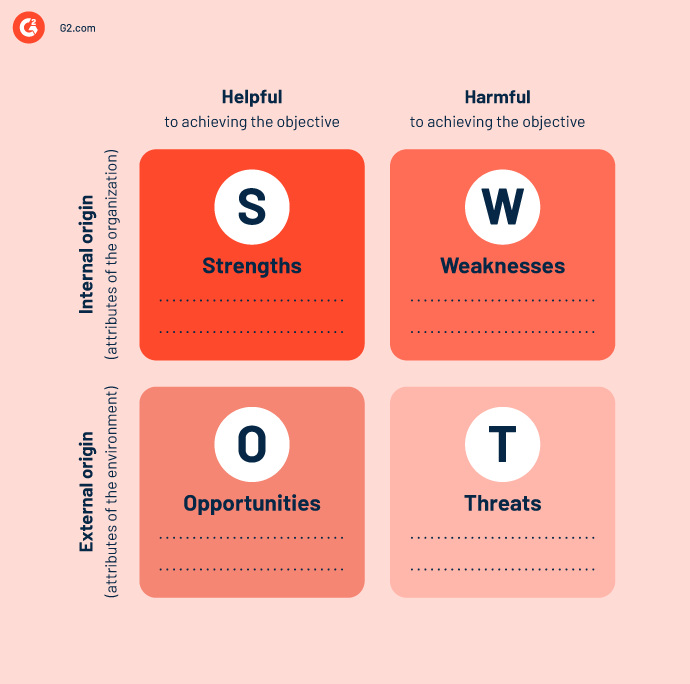Businesses need to be fully aware of themselves to compete in today's market.
Analyzing strengths and weaknesses help them understand where they currently stand and what they should do to grow further. SWOT analysis allows companies to identify their strong points and areas they can improve on. It enables them to find opportunities and threats that inform their strategies.
SWOT analysis needs in-depth research on current business operations and requires collaboration with many stakeholders. Organizations prefer using project management software to keep every stakeholder in the loop and ensure complete transparency throughout the process.
What is SWOT analysis?
Strength, weakness, opportunity, threat (SWOT) analysis, also referred to as situational analysis, is a strategic management framework used to analyze a business' competitive position. It includes assessing internal and external factors, which helps companies get a comprehensive overview of their current and future potential.
Companies should view SWOT analysis as a guide rather than a prescription. It helps key decision-makers aggregate data related to strengths, weaknesses, opportunities, and threats to inform their decision-making process. SWOT analysis promotes a data-driven approach to planning new initiatives where critical decisions are supported by data instead of presumptions or subjective beliefs.
It's advisable to seek feedback from diverse stakeholders to make the most of the SWOT analysis process. Ensure that the diverse group of people or voices openly express their opinions and suggestions.
Determining SWOT factors
Identifying factors and placing them on a SWOT matrix might sound easy, but it can be a tricky process. The best way to ensure a successful SWOT analysis is to carefully research factors and categorize them correctly.
Begin by determining if a factor is internally or externally influenced.
- Internal factors are resources available to the decision-maker or company. These resources are not necessarily physical and include processes, expertise, experience, and manpower.
- External factors are forces that influence the decision directly or indirectly. These can be difficult to identify if a decision-maker isn't aware of them. Individuals and teams should always do additional research to identify external factors that may affect the decision. External factors can include trends, regulations, policies, relationships, and demographics.
Once internal and external factors have been identified, decide if they're beneficial or detrimental for the given decision.
While it may seem like strengths and weaknesses may be obvious, context can affect which one a factor might be in a given situation.
For example, suppose a small company decides whether it wants to take on a solo project. In that case, its low employee count could be a weakness if the project requires a lot of manpower. However, if the project is more reliant on flexibility, a small workforce could actually be a strength since it can more easily change direction.
Decision-makers can ask these questions to identify and adequately categorize factors as they fill their SWOT matrix. These leading questions can facilitate brainstorming sessions and help identify factors that may not have been considered before. They can also assist in helping frame factors and how they'll interact with a given decision.
Want to learn more about Project Management Software? Explore Project Management products.
How to do a SWOT analysis
Listed below are questions decision-makers can ask themselves when brainstorming factors surrounding their decision.

Strengths
Businesses can evaluate their strengths by answering these questions:
- What are your company's competitive advantages? What does your company bring to the table that your competition doesn't?
- What relevant expertise or experience does your company and your team have?
- Do you have any helpful additional information surrounding the situation?
- Does your company have physical assets like money, physical spaces, equipment, or patents that apply here?
Weaknesses
Leadership can gain a better understanding of weaknesses or areas of improvement by seeking answers to the following questions:
- What are the areas where the company or product is less competitive? What kind of improvements would make them more competitive? Are they small or significant changes?
- Are you employing outdated or inefficient business processes that will hinder your progress?
- What assets are you missing? Do you lack human or financial capital? How difficult will it be for you to obtain these things?
- Is there information that you don't have? How important is this information to making a decision? How difficult would it be to find this information?
Opportunities
Companies can identify new opportunities by responding to these questions:
- Are there market, product, or social trends in your company's favor? Would it be easy to add functionality or brand differently to take advantage of specific trends?
- Are regulations changing in a way that makes it easier for your company to operate?
- Is there an event or conference coming up that your company could attend for visibility? Would it be possible for your company to speak or otherwise make itself a main figure at the event?
- Are there new emerging SaaS technologies that your product or company could use it? Would turning this into a more permanent asset (a strength) be an easy feat?
Threats
Organizations can foresee potential threats by answering these questions:
- Are your competitors currently doing something that makes it more challenging for you to operate or be noticed? How much capital would need to be expended to overcome that obstacle?
- Is consumer behavior changing in a way that doesn't favor you? How difficult will it be to pivot in a more favorable direction?
- Are there political policies or regulations that will make operating more expensive or add difficulty to a project? Are quality standards or certifications being modified that you have to account for in the future?
- Is there an environmental obstacle in the way? Is weather or climate not favorable for project or product?
SWOT analysis template
SWOT analysis allows decision-makers to look for relationships between favorable and unfavorable conditions that could indicate the chance of success should they go forward. It also forces them to look at a decision holistically. It can help confront biases toward the decision from both sides.
Tip: Download the SWOT analysis template and start identifying your strengths, weaknesses, opportunities, and threats.
The SWOT matrix functions similar to a pros and cons list but delineates external and internal factors more. While that doesn't sound like a massive difference on paper, differentiating between elements within a company's control and those in the environment offers a more realistic framework for success.
However, SWOT analysis isn't without its faults. It doesn't ask the decision-maker to prioritize factors, so they all appear to weigh the same when viewed uncritically. The key to a practical SWOT analysis is to consider that some elements may be more relevant or critical to the decision than others. Using SWOT in tandem with critical path management software, you can prioritize project work efficiently.
SWOT analysis can evaluate most decisions, if not all of them. Businesses use SWOT analysis while considering several possibilities, including new ventures or projects, rebranding, and merging.
SWOT analysis example
Below is a SWOT analysis example that reveals this world-famous business' internal strengths, weaknesses, external opportunities, and threats.
| Strengths | Weaknesses | Opportunities | Threats |
| Strong position and successful brand image in the market | Imitating company's business model isn't so difficult | Expand operations in developing markets | Increasing cybercrime |
| Customer-oriented brand | Loses margins in some markets | Improve profit margins by backward integration | Controversy |
|
Brings creative ideas and innovation to its products and services |
Owns limited physical stores | Grow brick-and-mortar presence | Aggressive competition |
|
Controls costs and lowers inventory replenishment time |
Faces a challenge in guaranteeing each product's safety | Personalized shopper service | Government regulations |
|
Leads the market in the online retail industry |
Product flops and failures | More acquisitions | Fake products and reviews |
How to use a SWOT matrix
Once the SWOT matrix has been filled out, the decision-maker can begin creating a strategy.
There isn't always a clear-cut decision after the SWOT matrix has been filled. The key here is to find relationships between the factors and establish if any strengths and opportunities can counteract the weaknesses and threats.
It's also important to remember that not all factors have equal weight in a scenario. Factors don't only interact with one another on a one-to-one basis. Decision-makers should think of how their factors interact and impact one another.
Suppose a decision-maker finds that there aren't enough strengths and opportunities to adequately address the harmful factors. In that case, they should proceed with caution. If the opposite is true, the decision-maker can confidently move forward.
How the Balanced Scorecard Helps
The Balanced Scorecard is a helpful framework for creating and managing a strategic plan based on the results of your SWOT analysis.
By sorting strategic objectives into four Balanced Scorecard perspectives (Finance, Customer, Internal Processes, and Learning & Growth), this framework helps you understand what areas of your business are affected by your strengths and weaknesses.
The opportunities and threats you discovered in your SWOT analysis can then inform the strategic initiatives you undertake to achieve your goals.
Let SWOT call the shot
Ultimately, if you want to know where your company is headed and how to plan for it, then SWOT analysis may be the best option for you. It shows the inherent strengths and weaknesses of a business via the latest industry environment and its own capabilities right now and the opportunities and threats currently present. As such, it's far more valuable than a balance sheet in helping to chart a course to success in a competitive market.
Learn more about strategic planning software and help your company set, plan and track progress toward ultimate business goals.

Jazmine Betz
Jazmine is a former senior market research analyst at G2. In her free time, she's playing video games or watching Lord of the Rings for the hundredth time.
